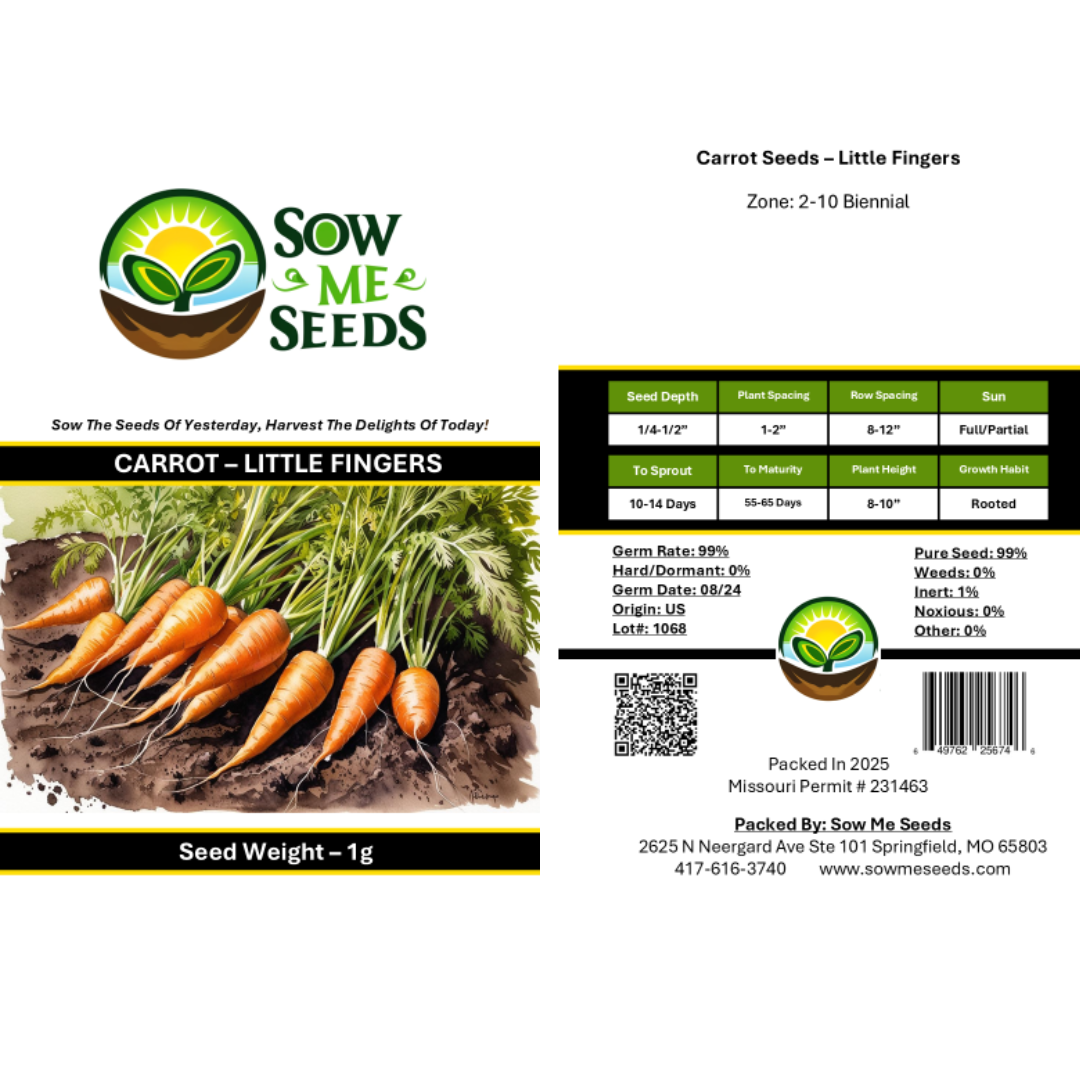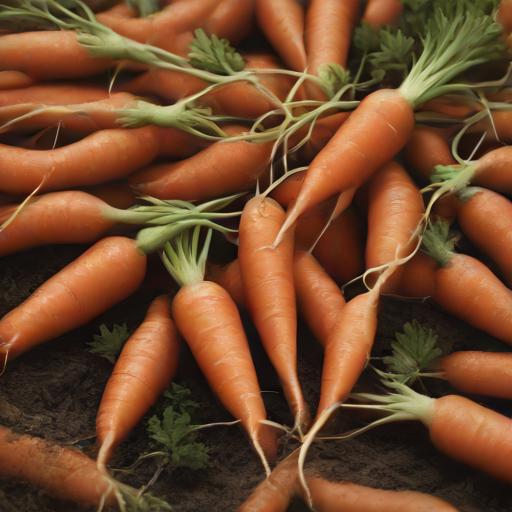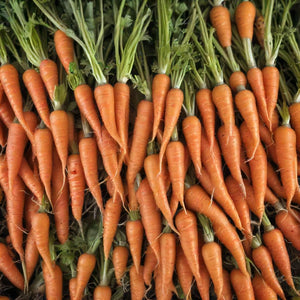- Hardiness Zone: 2-10 Biennial Typically Grown As An Annual
Seed Depth: 1/4–1/2 inch
Seed Spacing: 1–2 inches
Row Spacing: 8–12 inches
Sunlight: Full sun to partial shade
Days to Sprout: 10–14 days
Days to Maturity: 55–65 days
Growth Habit: Upright, root vegetable
Sunlight: Thrives in full sun but tolerates partial shade, especially in warmer climates.
Soil Type: Prefers loose, sandy, well-drained soil with a pH of 6.0–7.0. Remove rocks and debris to ensure straight root growth.
When to Plant: Sow seeds directly outdoors in early spring or late summer for a fall harvest. Carrots thrive in cool weather.
Direct Sowing: Plant seeds 1/4–1/2 inch deep, spacing them 1–2 inches apart in rows 8–12 inches apart. Thin seedlings to the desired spacing once they germinate.
Indoor Sowing: Not recommended; carrots grow best when directly sown outdoors.
Succession Planting: Sow every 2–3 weeks for a continuous harvest during cool seasons.
Watering: Water consistently to keep the soil evenly moist but not waterlogged. Avoid letting the soil dry out completely, which can lead to stunted growth.
Fertilizing: Use a low-nitrogen fertilizer or compost at planting to promote root development. Avoid over-fertilizing with nitrogen, which can cause excessive leafy growth.
Pruning: No pruning is needed, but remove weeds regularly to reduce competition.
Pest and Disease Control: Watch for carrot flies and root-knot nematodes. Use row covers and crop rotation to minimize pest risks.
When to Harvest: Harvest when roots are 3–4 inches long, typically 55–65 days after planting.
How to Harvest: Gently loosen the soil around the roots and pull them up by the tops. Avoid damaging roots during harvest.
Seed Collection: Allow some plants to bolt and form seed heads. Collect seeds once the heads are dry.
Storing Seeds: Store seeds in an airtight container in a cool, dry place.
Why You’ll Love It
Small and Sweet: Perfectly sized for lunchboxes, pickling, and fresh eating — with a mild, sugary flavor.
Quick to Mature: Harvest-ready in as little as 55 days — great for succession planting and impatient gardeners.
Great for Containers: Compact roots grow well in raised beds, grow bags, and even deep pots.
Smooth and Uniform: Produces slender, blunt-tipped carrots that require little to no peeling.
Plant Characteristics
Height: 8–12 inches (foliage)
Growth Habit: Upright, feathery greens with short, straight underground roots
Root Type: Small, cylindrical orange carrots with blunt tips
Days to Maturity: 55–65 days
Hardiness: Cool-season biennial grown as an annual
Flavor and Culinary Uses
Flavor: Mild, crisp, and extra sweet — especially when harvested young
Culinary Uses: Great for snacking, pickling, roasting whole, slicing into salads, or steaming lightly
Companion Planting Tips
Good Companions: Lettuce, onions, peas, and tomatoes
Avoid Planting Near: Dill or parsnips, which can interfere with growth
Bonus Benefit: Grows quickly and can be staggered for a continuous harvest all season long
Common Issues and Solutions
Forked or Misshapen Roots: Grow in loose, stone-free soil and avoid overcrowding
Poor Germination: Keep soil moist during sprouting and avoid planting too deeply
Carrot Rust Flies: Use floating row covers early or interplant with alliums to deter pests
Seeds Per Packet
| 1g | Approximately 640 |
| 5g | Approximately 3,200 |
Why You’ll Love It
Small and Sweet: Perfectly sized for lunchboxes, pickling, and fresh eating — with a mild, sugary flavor.
Quick to Mature: Harvest-ready in as little as 55 days — great for succession planting and impatient gardeners.
Great for Containers: Compact roots grow well in raised beds, grow bags, and even deep pots.
Smooth and Uniform: Produces slender, blunt-tipped carrots that require little to no peeling.
Plant Characteristics
Height: 8–12 inches (foliage)
Growth Habit: Upright, feathery greens with short, straight underground roots
Root Type: Small, cylindrical orange carrots with blunt tips
Days to Maturity: 55–65 days
Hardiness: Cool-season biennial grown as an annual
Flavor and Culinary Uses
Flavor: Mild, crisp, and extra sweet — especially when harvested young
Culinary Uses: Great for snacking, pickling, roasting whole, slicing into salads, or steaming lightly
Companion Planting Tips
Good Companions: Lettuce, onions, peas, and tomatoes
Avoid Planting Near: Dill or parsnips, which can interfere with growth
Bonus Benefit: Grows quickly and can be staggered for a continuous harvest all season long
Common Issues and Solutions
Forked or Misshapen Roots: Grow in loose, stone-free soil and avoid overcrowding
Poor Germination: Keep soil moist during sprouting and avoid planting too deeply
Carrot Rust Flies: Use floating row covers early or interplant with alliums to deter pests
Seeds Per Packet
| 1g | Approximately 640 |
| 5g | Approximately 3,200 |





Share and get 15% off!
Simply share this product on one of the following social networks and you will unlock 15% off!